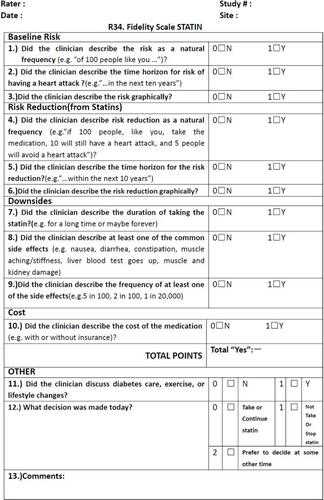Abstract
Background
The aim of this study was to evaluate the feasibility of using the Statin Choice decision aid to have discussions about starting a statin medication for cardiovascular risk reduction in Chinese patients with stable coronary artery diseases.
Methods
A prospective, pilot study of the Statin Choice decision aid in two teaching hospitals in Northern China was conducted. A total of seven clinicians were enrolled and underwent a 12-hour, group-based, in-person training on shared decision making (SDM) and the Statin Choice decision aid. Then, these clinicians used the Statin Choice decision aid in patients during a clinical encounter. A total of 86 patients aged 40−80 years, who had stable angina, were enrolled. All clinical encounters were video recorded. A team of three researchers viewed and scored all the encounter recordings to evaluate the SDM process and fidelity to the intervention using the OPTION scale and Fidelity scale, respectively. All the patients were followed up for 12 months to record adherence to statin and any major adverse cardiac events (MACEs).
Results
The average scores on the OPTION normalized score and Fidelity scale were 21 (range, 3–32; out of a possible, 48) and 10 (range, 6–10; out of a possible, 10), respectively. This suggested that Chinese clinicians who were using Statin Choice in their patients were able to exhibit behaviors consistent with SDM at a level that is similar to that reported in Western countries. After SDM, the statin adherence was 94.5% (69/73), and the proportion of MACEs was 2.9% (2/69).
Conclusion
Using an encounter decision aid developed in the US, it was feasible to implement SDM in a referral cardiology practice in Mainland China. Further work to ensure that the encounter aid is pertinent to the Chinese population and that SDM is tested in at-risk patients could contribute to the implementation of SDM across Mainland China.
Supplementary materials
Table S1 OPTION scale, median (range)
Table S2 Fidelity scale, median (range)
Acknowledgments
The authors thank Doctor Shuting Li, Doctor Yafei Lu, and other nursing staff of Cardiology Department of the First Affiliated Hospital of Dalian Medical University and Doctor Dongfeng Zhang from Beijing An Zhen Hospital, Capital Medical University for data collection and patient communication; Doctor Baolin Wu and Ms Na Xu for the follow-up of patients; and Ms Qi Li and Doctor Huaiyu Ding for reviewing and scoring all the videos. MRG was supported by CTSA Grant Number TL1 TR000137 from the National Center for Advancing Translational Science. The contents of this manuscript are solely the responsibility of the authors and do not necessarily represent the official views of the National Institutes of Health.
Disclosure
The authors report no conflicts of interest in this work.

